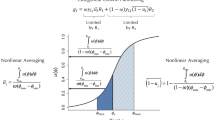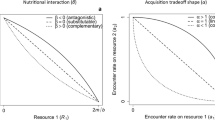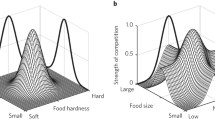Summary
How should a consumer of two resource types adapt to changes in their abundances? This paper shows that many different biological circumstances produce mixed responses; i.e. increasing availability of one resource increases the consumer's efforts to obtain it, while increasing availability of the other resource decreases the consumer's efforts at exploitation. This implies that competition from a second consumer species may cause convergent or divergent character displacement of the first species. The signs and magnitudes of the second derivative of the fitness function are important in determining which outcome occurs. The degree of resource limitation of the consumer species also influences the nature of adaptive shifts in resource use.
Similar content being viewed by others
References
Abrams, P. A. (1986) Character displacement and niche shift analyzed using consumer-resource models of competition.Theoret. Popul. Biol. 29, 107–60.
Abrams, P. A. (1987a) Alternative models of character displacement: I. Displacement when there is competition for nutritionally essential resources.Evolution 41, 651–61.
Abrams, P. A. (1987b) Alternative models for character displacement: II. Displacement when there is competition for a single resource.Amer. Natur. 130, 271–82.
Abrams, P. A. (1987c) The functional responses of adaptive consumers of two resources.Theoret. Popul. Biol. 32, 262–88.
Abrams, P. A. (1989) Decreasing functional responses as a result of adaptive consumer behavior.Evol. Ecol. 3, 215–20.
Abrams, P. A. (1990) Adaptive responses of generalistt herbivores to competition; convergence or divergence.Evol. Ecol. 4, 103–14.
Belovsky, G. E. (1984) Herbivore optimal foraging: a comparative test of three models.Amer. Natur. 124, 97–115.
Belovsky, G. E. (1986a) Generalist herbivore foraging and its role in competitive interactions.Amer. Zool. 26, 51–70.
Belovsky, G. E. (1986b) Optimal foraging and community structure: Implications for a guild of generalist grassland herbivores.Oecologia 70, 35–52.
Brown, W. L. Jr., and Wilson, E. O. (1956) Character displacement.Syst. Zool. 5, 49–64.
Case, T. J. (1981) Niche packing and coevolution in competition communities.Proc. Natl. Acad. Sci. USA.78, 5021–5.
Gendron, R. P. (1987) Models and mechanisms of frequency dependent predation.Amer. Natur. 130, 603–23.
Grant, P. R. (1972) Convergent and divergent character displacement.Biol. J. Linn. Soc. 4, 39–68.
Greenwood, J. J. D. (1984) The functional basis of frequency-dependent food selection.Biol. J. Linn. Soc. 23, 177–99.
Holt, R. D. (1977) Predation, apparent competition, and the structure of prey communities.Theoret. Popul. Biol. 12, 197–229.
Holt, R. D. (1983) Optimal foraging and the form of the predator isocline.Amer. Natur. 122, 521–41.
Lawlor, L. R., and Maynard Smith, J. (1976) The coevolution and stability of competing species.Amer. Natur. 110, 79–99.
Leon, J. A. and Tumpson, D. (1975) Competition between two species for two complementary or substitutable resources.J. theor. Biol. 50, 185–201.
Levins, R. (1968)Adaptation in Changing Environments. Princeton Univ. Press: Princeton, N.J.
MacArthur, R. H. and Levins, R. (1967) The limiting similarity, convergence, and divergence of coexisting species.Amer. Natur. 101, 377–85.
Milligan, B. G. (1985) Evolutionary divergence and character displacement of two phenotypically variable competing species.Evolution 39, 1207–22.
Roughgarden, J. (1976) Resource partitioning among competing species — A coevolutionary approach.Theoret. Popul. Biol. 9, 388–424.
Taper, M. and Case, T. J. (1985) Quantitative genetics models for the evolution of character displacement.Ecology 66, 355–71.
Author information
Authors and Affiliations
Rights and permissions
About this article
Cite this article
Abrams, P.A. Mixed responses to resource densities and their implications for character displacement. Evol Ecol 4, 93–102 (1990). https://doi.org/10.1007/BF02270907
Issue Date:
DOI: https://doi.org/10.1007/BF02270907




